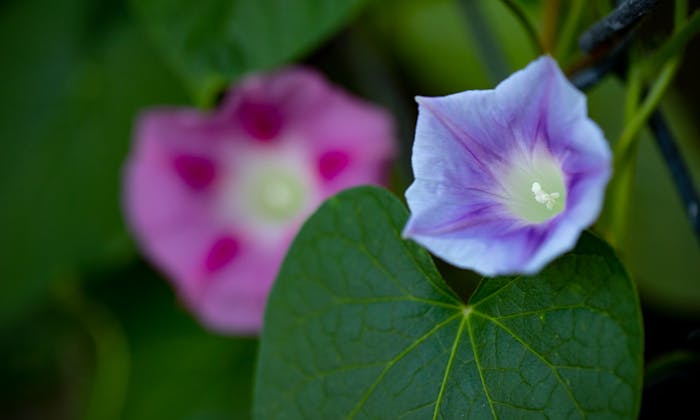An beautiful, easy to grow vine loved by hummingbirds.
A simple, beautiful, varied trumpet flower. Every morning a new crop of Morning Glory flowers appear on the vine, most to curl in and close off for good by afternoon. A new bevy emerges the next day. I suspect you could examine the vine at the end of one day and know were they will appear the next, but why spoil the surprise?
The common Morning Glory earns its name daily, by providing a new pop of colorful blooms every morning, most usually opening up before the sun has risen. These must be the easiest plants to grow, meaning the question about how to grow morning glories isn't nearly as interesting as whether you should.
Should You Grow Morning Glories?
I stood over the lower part of my yard one day in mid September. My dirt was baked and compacted, with nothing but dead, dry grass covering it. I had thrown some nosturtium seeds on it, and some sprouted lentils. I'd even been throwing bird seed across it, as an offering to the birds that might just grow some millet. And yes, I watered all of this, but nothing was happening. My dirt just seemed dead, knowing nothing about its history, I even wondered if it was poisonous. Perhaps it had been salted at some point, or saturated with weed killer.
So I was just trying to get something to grow. Our yard ends in a chain link fence bordering a wash. So I though, why not put some impossible to fail Morning Glories here? It can help hide the unsightly concrete of the wash and start to establish some greenery.
Gardeners either love or hate morning glories. Those who hate it, hate it for it's ability to spread and take over. Some compare it to bamboo in this ability. But the two are very different because Bamboo spreads underground by rhizome, while Morning Glories do it through incessent blooming and prolific germination.
I don't think I'll ever forget the first morning glory that appeared. A perfect pink trumped flower on my 2 foot vine that had only recently begun to establish itself. By afternoon it had closed up and shrivelled, leaving me to wonder if I had done something wrong before it occured to me to look up whether this was normal behavior.
The next day, nothing, then the day after that, three blooms. For the next week and onward, most days I would have several although a day or two got skipped. Over time, old vines die out and new ones cover them. They form a somewhat scraggley undercover. But they did their job of fillinout out my fence. Then I learned about native plants, and decided to replace them with native morning glories.
What Are Morning Glories?
When I think of Morning Glories, I'm mainly thinking of the ornamental flower, but the Morning Glory family is quite large, with some edible members. Perhaps the most recognizable member of this family is Ipomoea batatas, the Sweet Potato.
The most obvious difference between the Sweet Potato, and the ornamental varieties is the edible tubor. Sweet potatoes are true morning glories, but are not typically referred to as morning glories. Sweet Potatoes are often called "yams" in the United States, but true yams are from a completely different famaily and are not morning glories.
Another edible member of the Morning Glory family is Ipomoea aquatica, best known as "Water Spinach", and is not legal to grow in most states. It is an important crop in East and Southeast Asia. It is a problematic invasive species in Florida, but has nearly been eradicated. As it's name suggests, it is an aquatic plant, but can also be grown on dry land. It has not created the same problem in other states, but because of it's problems in Florida, it is banned without permit in most states. You won't find it at your local garden center.
Native Morning Glories
The good news is, California has several species of morning glory. They look very similar to the kind you find in nurseries, although the color options are a little limited. You won't find the "heavenly blue", but you can find elegant cream, pink and violet flowers.
Common names for our morning glories are "Island Morning Glory" or "Beach Morning Glory". They cover the Channel Islands but are also naturally found around our coastal scrub and in some of the drier, mountainous areas. When I went up to Monrovia Canyon Park for some post-fire restoration tree planting, these were all over some of the hillsides.
Once I got ahold of some native morning glory seeds, I knew I had to pull out my existing non-native morning glories. I wasn't sure how that would go since they are so famously weedy.
It actually wasn't that bad. The vines pull right out of the ground, they aren't that difficult to deal with. Removed them from the fence, which was a little tedious, especially for the segments that had dried on there. I probably could have skipped this part and left them there to wilt and decay on their own, but I wanted a fresh start here.
For a few weeks I watered where they had been, pulling up any sprouts that popped up, and they did. I'm not that confident in my ability to distinguish non-native from native morning glories, so I wanted to make sure any seeds that were still in the ground were allowed to germinate so I could remove them for good.

